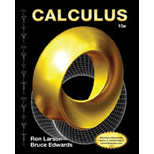
Concept explainers
Finding Intervals of Convergence In Exercises 89 and 90, find the intervals of convergence of (a) f(x). (b)
Want to see the full answer?
Check out a sample textbook solution
Chapter 9 Solutions
Calculus
- Given the graph of f'(x) below, where is fx) increasing? 6 4 4 6 a) Of(x) is increasing on the interval (-5, oo) b) Of(x) is increasing on the intervals (-oo - 5) and (5,7) c Of d) Of( e) Of(x) is increasing on the interval (-5,7) (x) is increasing on the interval (-00,7) (x) is increasing on the intervals (-5,5) and (7, co)arrow_forwardDiscuss limit(n →∞)fn on B and C for fn(x)= ∑nk=1xk; B=(-1,1); C=[-a,a], |a|<1 fn(x)=1/(1+nx); C=[0, ∞)arrow_forward(a) State the Mean Value Theorem. (b) Suppose we know that f(x) is continuous on the interval [-7.0] and differentiable on the interval (-7,0), that f(-7) = –3 and that f'(x) < 2 for all x. What is the largest possible value for f(0).arrow_forward
- The value (x, f(x)) of the maximum or minimum limit of the function 8 + f(x) = x3 - 6x2 + 4x and for the period 3 = x = 1- is (0.367,8.709) THE (2.999,-8.709) O (2,999, -6,999)arrow_forwardQ1 rwarrow_forward(x- 1) (x– 2)(x+ 1) Hint: using sign chart (x+ 2)(x- 3) (x+3) 2. Let f"(x) = and g'(x) = For what values of x are Ax) and g(x) both increasing?arrow_forward
- Determine the intervals on which the function is increasing/decreasing. f(x) = 4 In(x) - 17 arctan(x) Increasing: o(-0) u (0.) ㅇ(금) (-) ㅇ(0, 금) U (4, m) O none of the above Decreasing: o(-0) (0, ) ㅇ(능) 0(--) ㅇ(0, ) U(4,-) O none of the above Identify all local extrema with the first derivative test. (Enter your answers as a comma-separated list. If an answer does not exist, enter DNE.) local maximum local minimum X =arrow_forward★ Evaluate. [(sec*(x)) dxarrow_forwardFind the critical numbers of f, if any, (a) find the open intervals on which the function is increasing or decreasing, (b) apply the First Derivative Test to identify all relative extrema, and (c) use a graphing utility to confirm your results. f(x) = x/(x − 5)arrow_forward
- Infinite Limits (Convergent) fx) dx = lim fx)dx A. = B.= " f(x)dx = lim ff(x) dx C. f) dx=f(x) dx + f(x) dx Discontinuous Integral (Divergent) 1. @x = a: (discontinuity) f f(x) dx= lim f(x) dx 2. @x = b: i f(x)dx= lim f(x) dx t-b 3. @x = C; aarrow_forward(A) find the critical numbers of f, if any (B) find the open intervals on which the function is increasing or decreasing (C) apply the First Derivative Test to identify all relative extremaarrow_forward(a) Sketch the graph of the function on the given interval. Illustrate the midpoint Riemann sum by sketching the appropriate rectangles. Calculate the midpoint Riemann sum for n=4, being sure to show all work. Use a calculator to calculate the left Riemann sum for n=64. f(x)= 1-x^2 on [0,2] ; n=4 (b) For the previous function on the given interval, calculate the definite integral using the infinite limit of the Right Riemann Sum.arrow_forwardarrow_back_iosSEE MORE QUESTIONSarrow_forward_ios
 Calculus: Early TranscendentalsCalculusISBN:9781285741550Author:James StewartPublisher:Cengage Learning
Calculus: Early TranscendentalsCalculusISBN:9781285741550Author:James StewartPublisher:Cengage Learning Thomas' Calculus (14th Edition)CalculusISBN:9780134438986Author:Joel R. Hass, Christopher E. Heil, Maurice D. WeirPublisher:PEARSON
Thomas' Calculus (14th Edition)CalculusISBN:9780134438986Author:Joel R. Hass, Christopher E. Heil, Maurice D. WeirPublisher:PEARSON Calculus: Early Transcendentals (3rd Edition)CalculusISBN:9780134763644Author:William L. Briggs, Lyle Cochran, Bernard Gillett, Eric SchulzPublisher:PEARSON
Calculus: Early Transcendentals (3rd Edition)CalculusISBN:9780134763644Author:William L. Briggs, Lyle Cochran, Bernard Gillett, Eric SchulzPublisher:PEARSON Calculus: Early TranscendentalsCalculusISBN:9781319050740Author:Jon Rogawski, Colin Adams, Robert FranzosaPublisher:W. H. Freeman
Calculus: Early TranscendentalsCalculusISBN:9781319050740Author:Jon Rogawski, Colin Adams, Robert FranzosaPublisher:W. H. Freeman
 Calculus: Early Transcendental FunctionsCalculusISBN:9781337552516Author:Ron Larson, Bruce H. EdwardsPublisher:Cengage Learning
Calculus: Early Transcendental FunctionsCalculusISBN:9781337552516Author:Ron Larson, Bruce H. EdwardsPublisher:Cengage Learning





